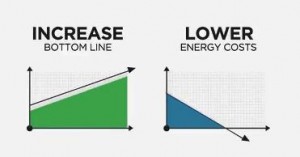It’s fascinating to watch energy efficiency projects evolve and really understand the factors that initiate them. Quite often energy efficiency is never even on the corporate radar. Energy efficiency is often an unexpected side effect of a desire to dramatically reduce costs!
A project that EAG submitted for approval last week serves as a perfect illustration!
Our CEO was contacted recently by an overseas company who had purchased a building in Michigan in order to manufacture products closer to their U.S. customers. With an extensive customer base in Michigan the Governor had given the company a compelling tax incentive to move to this part of the world.
The company purchased an 110,000 square foot building that was built in 1989 and was formerly used for light assembly, storage and office space. The new operation will have a heat treating facility and ultimately a 24/7 manufacturing operation. This change in operation created an expensive energy demand that has a deadline attached to it!
With a plan to ramp up production from 2 shifts, operating five days a week, to a 24/7 operation by 2018, the utility company made it clear that the current electrical service will not be capable of handling the ultimate energy load. A substantial upgrade to the service will be required and the building’s owner will be responsible for all cost associated with the upgrade. No other company in the industrial park has a need for that much energy, so cost sharing is not an option! The cost is projected to be several million dollars!
An urgent discussion was initiated by the company’s leadership to figure out how to reduce energy use in order to prevent or delay the utility upgrade until way into the future. Ideally the upgrade would be required at least four years out.
The company directors started to look at the lowest hanging fruit for reducing energy demand. In this case that was determined to be lighting which has two factors favoring an upgrade. First – due to a very high ceiling, the amount of light at the floor, while adequate for storage, was not bright enough for a manufacturing operation. They simply needed better lighting. Secondly – the present lighting was highly inefficient and produced a lot of heat. Not what you want in a heat treating facility!
Several quotes on a lighting upgrade resulted in a return to the drawing board. It was going to cost a minimum of $300,000.00 just to upgrade the interior lights which consisted of three hundred 400 watt fixtures in the manufacturing area alone! Other options were needed if cash flow was to be protected!
One of the company’s contractors mentioned Michigan’s Property Assessed Clean Energy (PACE) for financing the replacement of older inefficient technologies. The directors wanted to understand PACE and were referred to our CEO, Scott Ringlein, to learn more*.
“From a questionable lighting replacement project to a complete energy renovation that protects cash flow!”
 It was then that the energy efficiency discussion really took off. Ringlein discussed all the options that PACE opened up for a company using no money out of their pocket! They were now considering solar, lighting controls, indoor and outdoor LEDs, light harvesting, computer coordinated HVAC, on demand hot water system, electric forklifts, and the list goes on! PACE would finance the complete project. It would be repaid via a special property tax assessment, similar to ones levied for sewers, sidewalks, streets, etc. And, if the building were ever sold, the new owner would be responsible for paying the special assessment. Unlike traditional commercial loans, no loan payoff would complicate a potential future sale of the building!
It was then that the energy efficiency discussion really took off. Ringlein discussed all the options that PACE opened up for a company using no money out of their pocket! They were now considering solar, lighting controls, indoor and outdoor LEDs, light harvesting, computer coordinated HVAC, on demand hot water system, electric forklifts, and the list goes on! PACE would finance the complete project. It would be repaid via a special property tax assessment, similar to ones levied for sewers, sidewalks, streets, etc. And, if the building were ever sold, the new owner would be responsible for paying the special assessment. Unlike traditional commercial loans, no loan payoff would complicate a potential future sale of the building!
From a questionable lighting replacement project to a complete energy renovation that protects their cash flow, frees up cash from unneeded energy use, and delays or prevents the impending utility upgrade. Needless to say the executives were excited!
This project is first and foremost about the company’s desire to save money! Too often those of us in the energy efficiency field make energy efficiency the top priority in our marketing and discussions even though that’s probably not the chief concern of our customer. While there is a growing trend of companies embracing corporate sustainability goals – cutting costs and improving profitably are probably higher on the list of priorities. On this project, saving the client money was also our chief concern – and in the process the whole operation will now be a lot more energy efficient. A win for the company and a win for energy efficiency!
The Energy Alliance Group of Michigan is a leader in clean energy PACE project development and financing.
* If you would like to learn more about PACE you can watch a recorded webinar or consider attending the upcoming live PACE seminar.


Leave a Reply